A History of Port Milwaukee
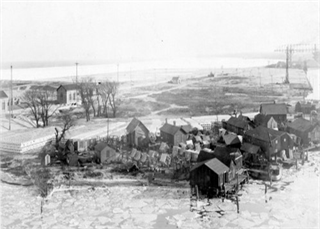 Milwaukee began as a Great Lakes port in 1835, when the first commercial cargo vessel called at the struggling new village on the west shore of Lake Michigan. Settlers and traders were drawn to the site because of its Indian population, its access to the "western frontier" afforded by three separate streams; the Milwaukee, Menomonee and Kinnickinnic rivers, which flow into Lake Michigan at a central Point in Milwaukee harbor. The streams, originally of interest to the fur traders because it afforded penetration to the interior by canoe, have been intensively developed with dock facilities, and expanded by dredging and channel improvements, and have become the focal point of a substantial commercial and industrial harbor development, handling millions of tons of commerce annually.
Milwaukee began as a Great Lakes port in 1835, when the first commercial cargo vessel called at the struggling new village on the west shore of Lake Michigan. Settlers and traders were drawn to the site because of its Indian population, its access to the "western frontier" afforded by three separate streams; the Milwaukee, Menomonee and Kinnickinnic rivers, which flow into Lake Michigan at a central Point in Milwaukee harbor. The streams, originally of interest to the fur traders because it afforded penetration to the interior by canoe, have been intensively developed with dock facilities, and expanded by dredging and channel improvements, and have become the focal point of a substantial commercial and industrial harbor development, handling millions of tons of commerce annually.
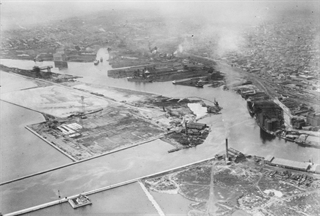 The "Inner Harbor" concept, with port development following river channels, is fairly common in the Great Lakes region, reflecting the natural impulse for navigation to penetrate inland.
The "Inner Harbor" concept, with port development following river channels, is fairly common in the Great Lakes region, reflecting the natural impulse for navigation to penetrate inland.
Milwaukee, however, departed from the common pattern of other Great Lakes cities in the planning and development of its lakefront port. Recognizing the industrial value of its inner harbor, Milwaukee also realized that shipping could not be crowded indefinitely into congested river channels, hampered by bridges, with street traffic in turn interrupted by bridge openings. Milwaukee, therefore, devised a comprehensive plan to acquire strategic lakefront areas and to develop an outer harbor, under municipal control, with modern port facilities.
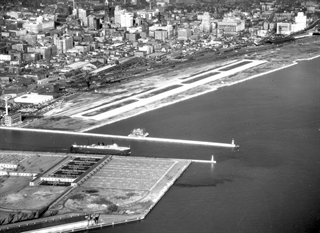 The first major improvement in converting the harbor from its original natural condition came in 1857, when the "Straight Cut" or new harbor entrance was completed. This project involved abandonment of the actual mouth of the Milwaukee River and construction of a new outlet a half mile to the north.
The first major improvement in converting the harbor from its original natural condition came in 1857, when the "Straight Cut" or new harbor entrance was completed. This project involved abandonment of the actual mouth of the Milwaukee River and construction of a new outlet a half mile to the north.
Because of numerous disasters to shipping on Lake Michigan, Congress, in 1881, made provision to create a Harbor of Refuge in Milwaukee by the extension of a breakwater across the Bay, from McKinley Beach at the north, in a southerly direction; succeeding acts of Congress provided additional appropriations to complete the breakwater project.
In 1900, Mayor David S. Rose recommended the construction of a system of docks and terminals in deep water outside of Jones Island because, as he stated, the rivers were becoming inadequate to meet the demands of increasing commerce. District Army Engineer, Colonel Warren, after making a study of the proposition, and in his report to the Secretary of War, Elihu Root, declared against an outer harbor, which report was promptly approved by the Secretary of War. Mayor Rose persisted, however, and in spring 1900, a committee of ten citizens was appointed to a Permanent Harbor Improvements Committee. That Committee made a study of the project. After several months reported to the Mayor and the Common Council, recommending that the channels in the inner harbor be deepened, that the federal government be requested to make a permanent survey of Milwaukee harbor, and that permanent harbor lines be established. The Committee made no recommendation as to Jones Island and the outer harbor development. In August 1903, Colonel Warren submitted a report to the Chief of Engineers, outlining a number of improvements in the inner harbor, among which were: enlargement of the Kinnickinnic River to a width of 200 feet; the construction thereon of two turning basins of sufficient size to accommodate 600-foot vessels; the widening of the Menomonee River by the removal of a corner at the entrance of the South Menomonee Canal and the removal of another on the same channel just opposite the site of Milwaukee Road grain elevator "A." The City was required to acquire the lands necessary for widening the channels and creating turning basins, after which the federal government was to do the necessary dredging; Congress adopted this project March 3, 1905. The City of Milwaukee acquired several pieces of land necessary for widening the Kinnickinnic Basin, but aside from that, nothing was accomplished toward the realization of the project.
In May 1908, the Common Council appointed a committee of five members to ascertain the cost of acquiring Jones Island, and the feasibility of establishing harbor terminals on those lands. At the same time, the Common Council adopted a resolution in favor of an outer harbor, and requested the U.S. Government to make the preliminary survey. Accordingly, in 1909, Congress ordered another survey of the Milwaukee outer harbor project. In response to that authorization, the U.S. District Engineer, Major C.S. Bromwell, submitted a report on the preliminary survey, recommending that a plan and estimate of an outer harbor be prepared, it being his judgment that it was probable that such a harbor would be needed in the not far distant future.
In June 1909, the Common Council Special Committee of five reported in favor of the acquisition of Jones Island and the establishment of municipal terminals there. The Committee was promptly authorized to engage Isham Randolph, C.E., of Chicago, to make a full, detailed engineering report and to submit a plan of development. This plan was submitted in spring 1910, but the Common Council indefinitely postponed the resolution, which favored an outer harbor, and rejected the Randolph plan.
In October 1911, Mayor Emil Seidel, by previous authorization, appointed a Harbor Commission of nine citizens of Milwaukee, conversant with harbor and shipping matters, to study the needs of Milwaukee with respect to harbor facilities, and to act in an advisory capacity to the Common Council. The first meeting of the new Commission was held on November 22, 1911, at which it effected an organization with William George Bruce as Chairman. In February 1912, the Harbor Commission was formally organized, and in the meantime the Common Council made financial provisions for the execution of its work. In May 1912, the Harbor Commission rendered a report against the acquisition of Jones Island for outer harbor purposes, and recommended development of the inner side of Jones Island, together with deepening and revetting of Kinnickinnic Basin. Having made this report, the activities of the first Harbor Commission ceased, it having been declared an illegal body by the Common Council because the Council had not confirmed the appointments to its membership.
On October 12, 1912, Mayor G.A. Bading, upon authorization by the Common Council, appointed a new Harbor Commission. This reorganized Commission, after considerable study, urged the early acquisition of Jones Island by the City, because it offered the only remaining opportunity for the municipality to acquire water frontage capable of a comprehensive terminal development. Accordingly, on July 7, 1913, the Common Council provided the necessary funds, and ordered the condemnation of Jones Island as far south as the old harbor entrance. Before the proceedings started, the Sewerage Commission was authorized to acquire the north 1,000 feet of the Island for a municipal sewage disposal plant.
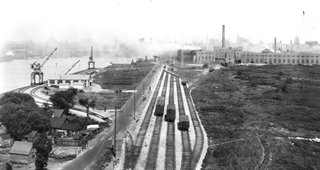 In August 1914, the Harbor Commission effected an agreement between the Chicago & NorthWestern Railroad and the City of Milwaukee, establishing a line showing the division of property on the North Harbor Tract. During its regime, that Commission permitted the removal of obstructing corners on the Menomonee River and South Menomonee Canal, and established a uniform system of harbor lines; construction of the rubble mound breakwater along the shore of Lake Michigan from Wisconsin Avenue to the harbor entrance; revetment of the inner side of Jones Island; bulk heading in the Lake to protect the fill on the outside of Jones Island; a survey by the federal government to determine the need of additional breakwater protection at Milwaukee; condemnation of the north half of Jones Island and the inauguration of proceedings and condemnation of the lower half of the Island as far south as Wilcox St.; and legislation granting authority to the City of Milwaukee to create a Board of Harbor Commissioners with power to plan harbor and waterway improvements, subject to the approval of the Common Council. In June 1919, that Commission, by authorization of the Common Council, engaged Mr. H. McClellan Harding, of New York City, to study and prepare an engineering report and plans pertaining to he Milwaukee harbor project. The plans were received and submitted to the Common Council, and approved in June 1920. That was the last act of that Harbor Commission.
In August 1914, the Harbor Commission effected an agreement between the Chicago & NorthWestern Railroad and the City of Milwaukee, establishing a line showing the division of property on the North Harbor Tract. During its regime, that Commission permitted the removal of obstructing corners on the Menomonee River and South Menomonee Canal, and established a uniform system of harbor lines; construction of the rubble mound breakwater along the shore of Lake Michigan from Wisconsin Avenue to the harbor entrance; revetment of the inner side of Jones Island; bulk heading in the Lake to protect the fill on the outside of Jones Island; a survey by the federal government to determine the need of additional breakwater protection at Milwaukee; condemnation of the north half of Jones Island and the inauguration of proceedings and condemnation of the lower half of the Island as far south as Wilcox St.; and legislation granting authority to the City of Milwaukee to create a Board of Harbor Commissioners with power to plan harbor and waterway improvements, subject to the approval of the Common Council. In June 1919, that Commission, by authorization of the Common Council, engaged Mr. H. McClellan Harding, of New York City, to study and prepare an engineering report and plans pertaining to he Milwaukee harbor project. The plans were received and submitted to the Common Council, and approved in June 1920. That was the last act of that Harbor Commission.
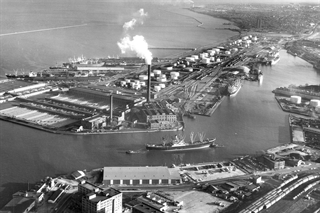 The Common Council created the Board of Harbor Commissioners of the City of Milwaukee June 1, 1920, under authority granted by Chapter 289, Laws of Wisconsin, 1919. That legislative action authorized the new Board of Harbor Commissioners to employ personnel and to award contracts for the operation and maintenance of the harbor. All improvements involving expenditure of money were subject to Common Council approval.
The Common Council created the Board of Harbor Commissioners of the City of Milwaukee June 1, 1920, under authority granted by Chapter 289, Laws of Wisconsin, 1919. That legislative action authorized the new Board of Harbor Commissioners to employ personnel and to award contracts for the operation and maintenance of the harbor. All improvements involving expenditure of money were subject to Common Council approval.
The membership of the Board was confined to five qualified electors of the City of Milwaukee, with terms extending over a three-year period. Agreeable to the action of the Common Council, Mayor Daniel W. Hoan, appointed five citizens to membership on the Board. William George Bruce was elected Chairman of the new Commission, and served in that capacity until 1949. Mr. Bruce held the office of Chairman of the Harbor Commission and later, the Board of Harbor Commissioners, for 38 consecutive years.
In November 1922, a contract was made for leveling the North Harbor Tract to an elevation of five feet above City Datum. In June 1923, Governor Blaine signed the bills which amended the Harbor Law and also Chapter 358 of the Laws of Wisconsin, 1919, in which the State of Wisconsin ceded to the City, the title and interest of the State of Wisconsin to submerged lands extending into the Lake for a distance of 1,500 feet from the shore line for construction of harbor facilities. In 1924, the Board of Harbor Commissioners received a proposal from the Illinois Steel Company, in lieu of condemnation. An agreement between the City and the Illinois Steel Company for the exchange of lands was entered into on March 15, 1926. The Illinois Steel Company property on Jones Island was key property to developing rail connections. Early 1926, the revetment on the inside of Jones Island was reinforced by two additional rows of anchorage. In November 1927, the City of Milwaukee for utilization purchased the Abbot Tract, lying west and south of South Bay Street, by the Board of Harbor Commissioners as a railroad interchange yard. In September 1927, dredging and filling of a portion of Jones Island was taken under the supervision of this Commission, as the first step in developing the Jones Island carferry terminal.
The Board of Harbor Commissioners has functioned continuously since July 1, 1920. Section 30.37, Wisconsin Statutes, provides the authority under which the Board was created, and under which it operates.
Under Section 30.37 (2), Wisconsin boards of harbor commissioners are created by resolution of the governing body of the municipality. Such resolution states whether the board is to be composed of three, five, seven or nine members. From 1920 through 1968, the Board of Harbor Commissioners was comprised of five members. By resolution adopted December 30, 1968, the Common Council increased the membership to seven Commissioners: one was designated to be a member of the Common Council, and the others were to be citizens. By subsequent resolution adopted June 12, 1984, the Chairman of the Common Council Public Improvements Committee was designated as the Alderperson member of the Board of Harbor Commissioners.